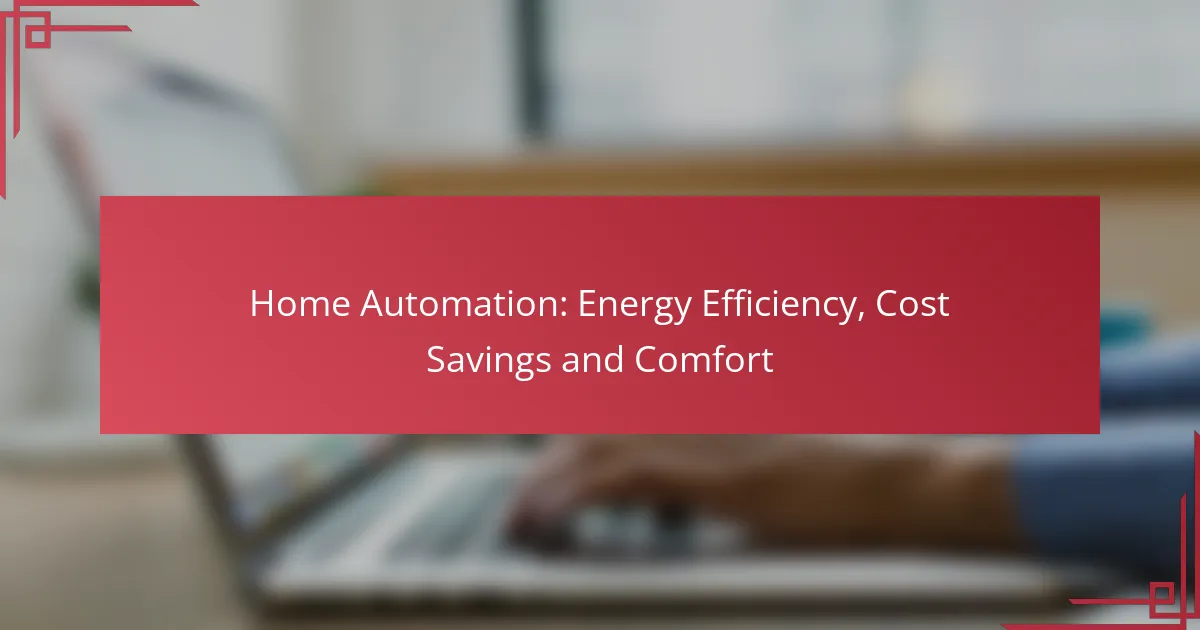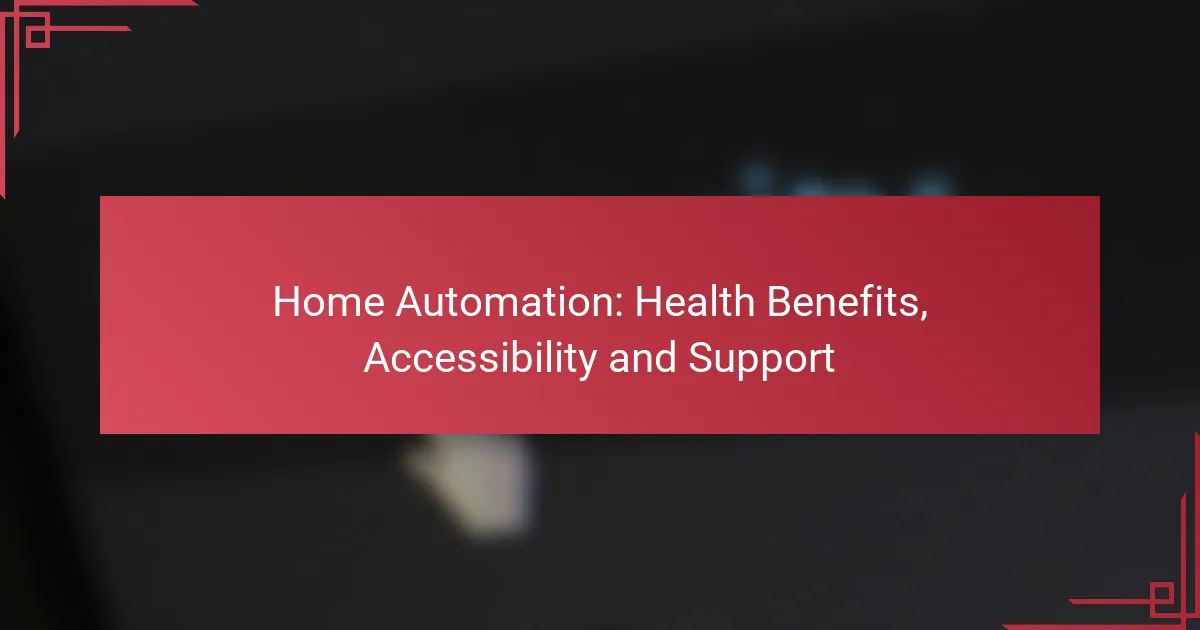Home automation offers advanced security features that significantly enhance the safety of your home. With smart locks, surveillance cameras, and motion sensors, homeowners can enjoy real-time monitoring and instant alerts, ensuring they are always aware of their property’s security status. These integrated systems not only provide peace of mind but also allow for quick responses to any unusual activities, making home security more efficient and effective.

What are the best home automation security features in Ireland?
The best home automation security features in Ireland include smart locks, surveillance cameras, alarm systems, motion sensors, and smart doorbells. These technologies enhance home security by providing remote access, real-time monitoring, and instant alerts, ensuring peace of mind for homeowners.
Smart locks
Smart locks offer keyless entry and can be controlled remotely via smartphone apps. They enhance security by allowing homeowners to grant access to guests without needing physical keys, and many models include features like temporary access codes.
When choosing a smart lock, consider compatibility with your existing door hardware and the lock’s security ratings. Look for options that offer two-factor authentication for added protection.
Surveillance cameras
Surveillance cameras are essential for monitoring your property in real-time. Many modern systems allow for remote viewing through mobile apps, enabling homeowners to check in on their property from anywhere.
Opt for cameras with features like night vision, motion detection, and cloud storage for recorded footage. Ensure the cameras comply with local data protection regulations, such as GDPR, to safeguard privacy.
Alarm systems
Alarm systems provide alerts for unauthorized access and can deter potential intruders. Many systems now integrate with home automation platforms, allowing for seamless operation with other security features.
Consider systems that offer professional monitoring services for immediate response to alarms. Look for options that allow customization based on your specific security needs and property layout.
Motion sensors
Motion sensors detect movement and can trigger alarms or notifications when unusual activity is detected. They are often used in conjunction with other security features to enhance overall effectiveness.
Choose sensors that can differentiate between pets and humans to avoid false alarms. Placement is crucial; install them in areas with high foot traffic and near entry points for optimal coverage.
Smart doorbells
Smart doorbells combine a camera and intercom system, allowing homeowners to see and communicate with visitors remotely. They enhance security by providing a visual record of who approaches your door.
Look for doorbells with features like motion detection, night vision, and two-way audio. Ensure they are compatible with your home network and consider models that offer cloud storage for video footage.
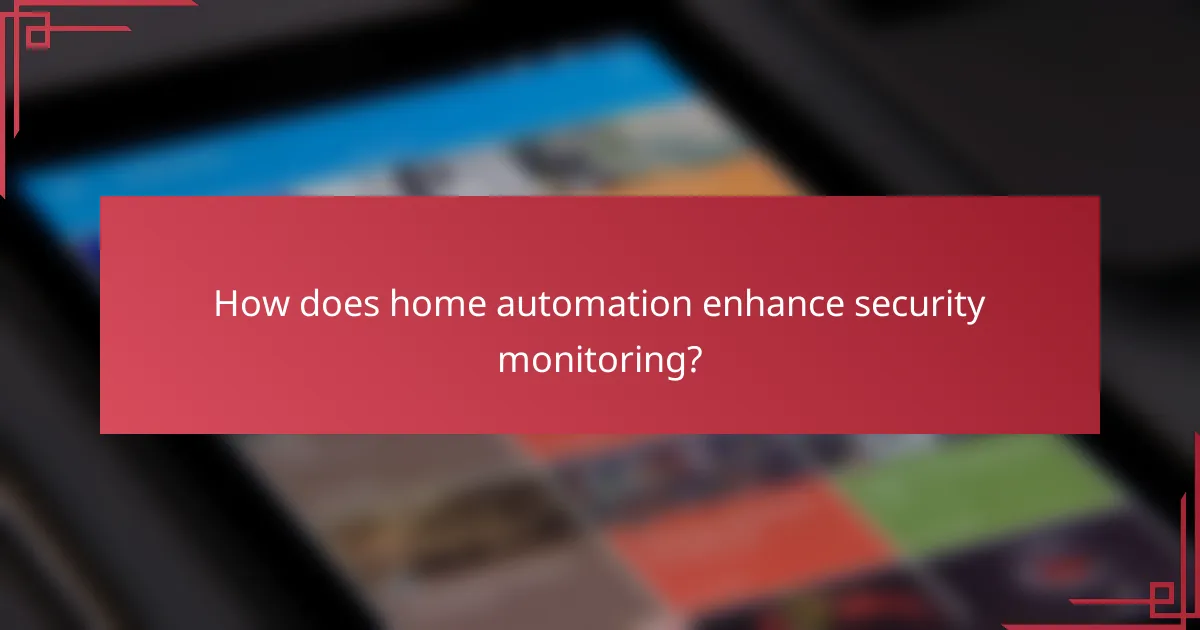
How does home automation enhance security monitoring?
Home automation significantly improves security monitoring by providing real-time data and control over security systems. Automated systems can detect unusual activities, send alerts, and allow homeowners to respond quickly, enhancing overall safety.
Real-time alerts
Real-time alerts are crucial for effective security monitoring. Home automation systems can instantly notify homeowners via smartphone notifications, emails, or text messages if they detect any suspicious activity, such as unauthorized entry or unusual motion. This immediate feedback allows for prompt action, potentially preventing theft or damage.
To maximize the effectiveness of alerts, ensure that your system is configured to differentiate between normal and abnormal activities. For instance, setting up specific zones for monitoring can reduce false alarms while maintaining vigilance in critical areas.
Remote access
Remote access is a key feature of home automation that enhances security monitoring. Homeowners can view live camera feeds, control locks, and manage alarms from anywhere using mobile apps. This capability allows for constant oversight, even when away from home.
When choosing a system, look for options that offer secure remote access with encryption to protect your data. Additionally, consider systems that allow you to grant temporary access to trusted individuals, such as house sitters or maintenance personnel, ensuring security without sacrificing convenience.
Integration with emergency services
Integrating home automation systems with emergency services can significantly enhance security monitoring. Many modern systems can automatically alert local authorities in case of a break-in, fire, or medical emergency, ensuring a swift response.
When selecting a home automation system, check for compatibility with local emergency services and any associated fees. Some systems may offer direct connections to police or fire departments, which can be invaluable during critical situations, potentially reducing response times.
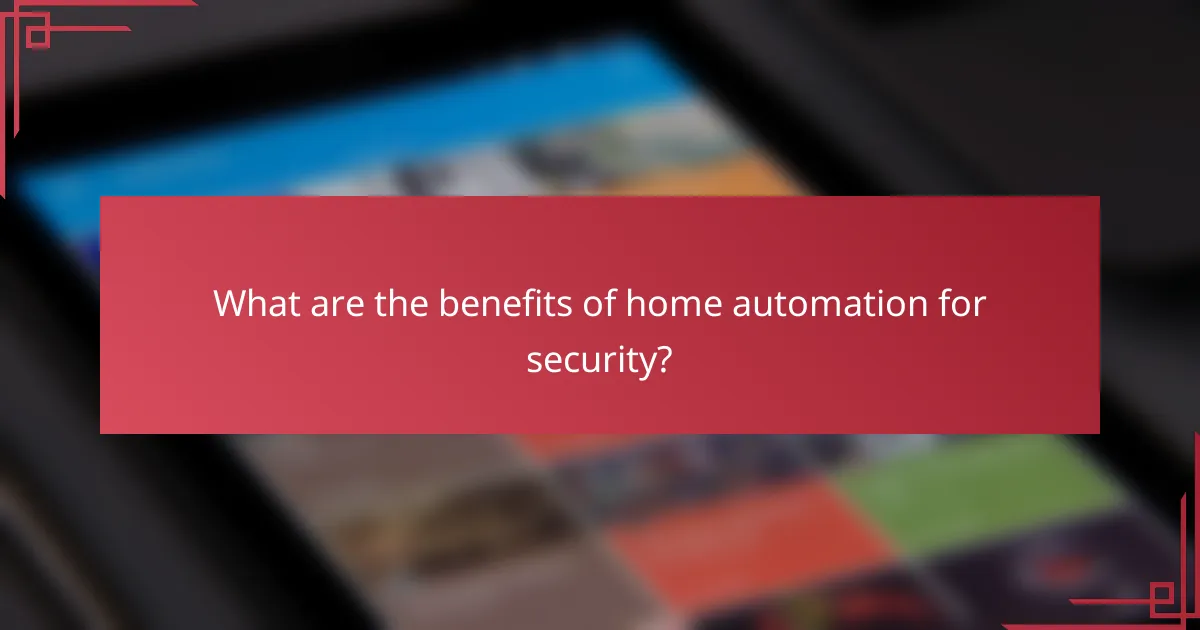
What are the benefits of home automation for security?
Home automation enhances security by integrating smart technology that allows for real-time monitoring, alerts, and control of security systems. This results in improved safety, convenience, and potential cost savings for homeowners.
Increased convenience
Home automation systems streamline security management by allowing homeowners to control locks, cameras, and alarms from their smartphones or tablets. This means you can lock your doors or view camera feeds remotely, providing flexibility and ease of use.
Many systems can be programmed to operate automatically based on your routines. For example, lights can turn on when you arrive home, or alarms can be set to activate when you leave, enhancing both security and convenience.
Cost savings on insurance
Installing a home automation security system can lead to significant savings on homeowner’s insurance premiums. Many insurance companies offer discounts ranging from 5% to 20% for homes equipped with monitored security systems.
To maximize savings, ensure your system includes features like motion detectors, security cameras, and smart locks, as these are often recognized by insurers as effective deterrents against theft and vandalism.
Enhanced peace of mind
Home automation provides peace of mind by allowing homeowners to monitor their property in real-time. Alerts can be sent directly to your phone if unusual activity is detected, enabling quick responses to potential threats.
Additionally, many systems offer integration with emergency services, ensuring that help can be dispatched promptly if needed. Knowing that you can check on your home anytime contributes significantly to a sense of security.

How to choose the right home automation security system?
Choosing the right home automation security system involves assessing your specific security needs, comparing available features, and ensuring compatibility with your existing devices. A well-selected system enhances safety while integrating seamlessly into your home environment.
Assessing your security needs
Start by identifying the areas of your home that require monitoring, such as entry points, windows, and outdoor spaces. Consider the level of security you desire, whether it’s basic surveillance or advanced features like motion detection and facial recognition.
Evaluate your lifestyle and potential risks. For instance, if you travel frequently, a system with remote access and alerts may be essential. Additionally, consider any local crime statistics to determine the level of security necessary for your area.
Comparing features
When comparing home automation security systems, focus on key features such as video surveillance quality, alarm systems, and smart home integration. Look for systems that offer high-definition video, night vision, and two-way audio for effective communication.
Consider additional features like cloud storage for video footage, mobile app access for real-time monitoring, and compatibility with smart home devices like lights and locks. A comparison chart can help visualize these features across different brands.
Evaluating compatibility
Ensure that the security system you choose is compatible with your existing home automation devices. Check for integration with platforms like Amazon Alexa, Google Assistant, or Apple HomeKit to enhance functionality.
Review the system’s requirements, such as Wi-Fi connectivity and power sources, to avoid installation issues. If you have a mix of older and newer devices, consider systems that offer backward compatibility or flexible integration options.
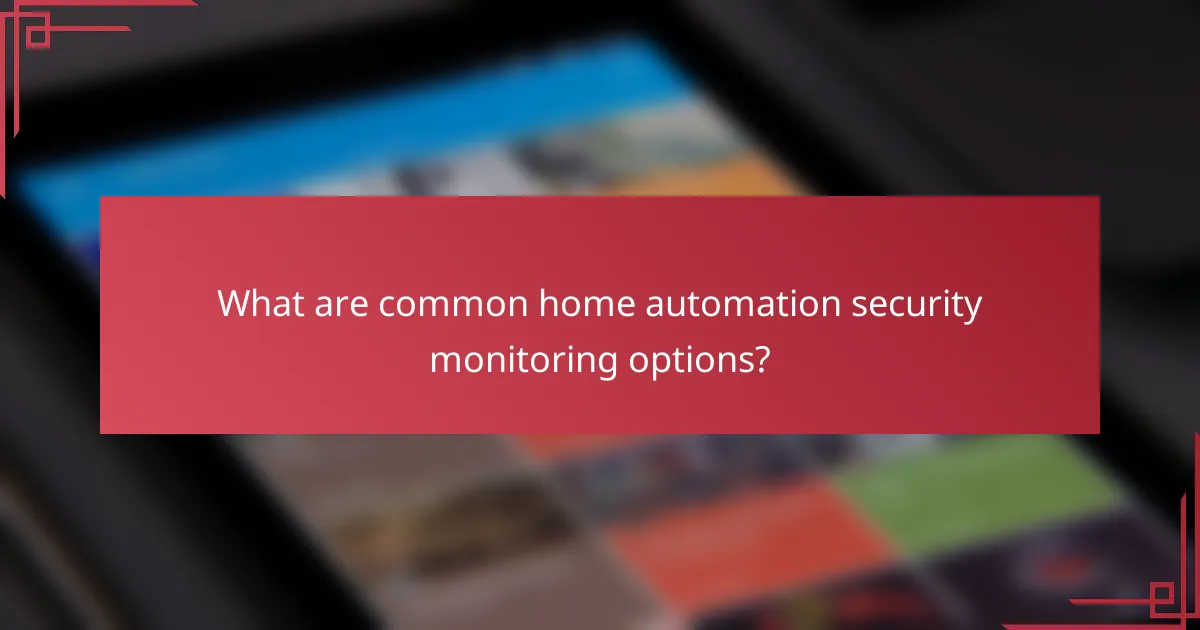
What are common home automation security monitoring options?
Common home automation security monitoring options include professional monitoring services, self-monitoring apps, and cloud storage for video footage. Each option offers different levels of oversight, convenience, and cost, allowing homeowners to choose based on their specific needs and preferences.
Professional monitoring services
Professional monitoring services involve hiring a third-party company to oversee your home security system. These services typically provide 24/7 monitoring, immediate alerts to authorities in case of emergencies, and often include equipment installation and maintenance.
When selecting a professional service, consider factors such as monthly fees, contract length, and response times. Many companies offer packages that can range from basic monitoring to comprehensive security solutions, including fire and medical alerts.
Self-monitoring apps
Self-monitoring apps allow homeowners to manage their security systems through smartphones or tablets. These apps provide real-time alerts, remote access to cameras, and the ability to control devices like locks and lights from anywhere.
While self-monitoring can save on costs, it requires the homeowner to be vigilant and responsive. Ensure your app is compatible with your security devices and check for features like push notifications and user-friendly interfaces.
Cloud storage for video footage
Cloud storage for video footage enables users to save and access recorded security camera footage online. This option is beneficial for reviewing incidents and ensuring that footage is not lost due to hardware failures.
When choosing a cloud storage solution, consider the amount of storage offered, subscription costs, and the duration for which footage is retained. Many services provide plans that allow for several days to weeks of storage, depending on your needs and budget.
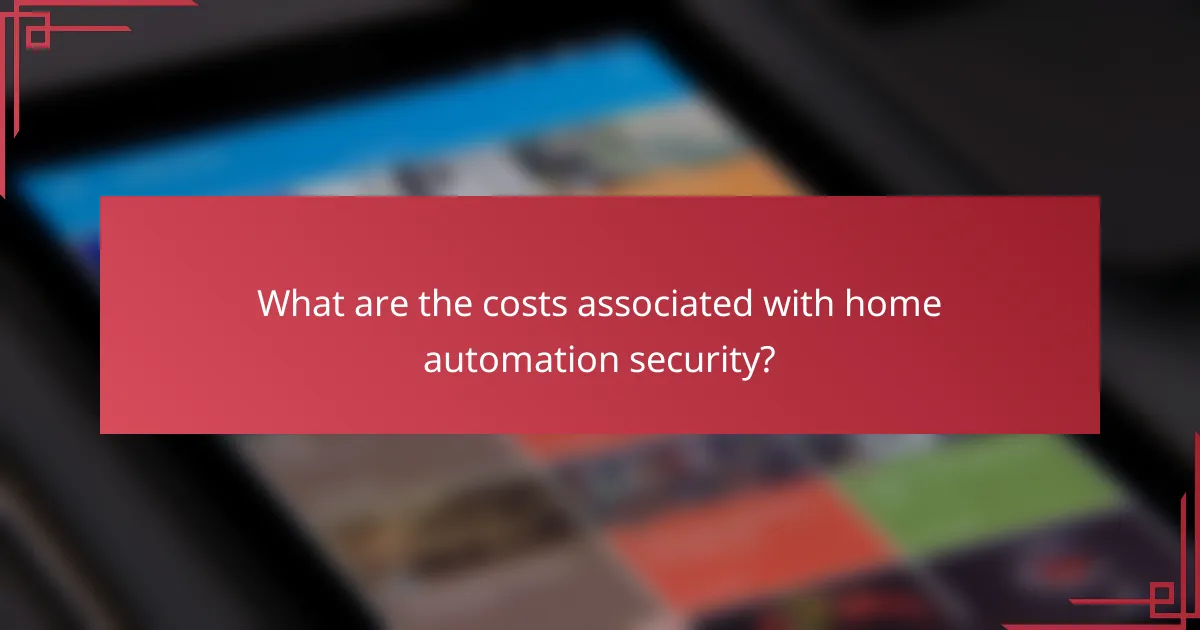
What are the costs associated with home automation security?
The costs associated with home automation security can vary significantly based on the complexity and scale of the system. Generally, homeowners can expect to invest in initial setup costs, ongoing maintenance, and potential subscription fees for monitoring services.
Initial setup costs
Initial setup costs for home automation security typically range from a few hundred to several thousand dollars. This includes purchasing hardware such as cameras, sensors, and smart locks, as well as installation fees if professional help is needed.
For a basic system, homeowners might spend around $200 to $500 on equipment, while more advanced setups with multiple cameras and sensors can exceed $1,500. It’s essential to assess your specific security needs to determine the right investment.
Consider whether you want a DIY system or a professionally installed one. DIY options can save on labor costs but may require more time and technical know-how. On the other hand, professional installation ensures proper setup but adds to the overall expense.

